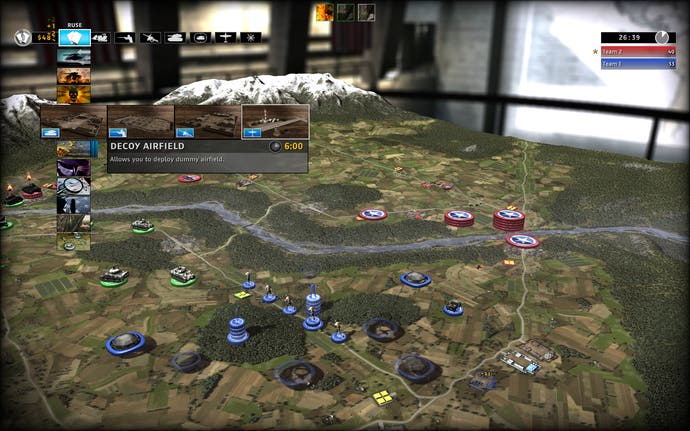R.U.S.E.
Command and console.
Radio Silence, for example, hides all your units in a sector from your opponent's strategic view, though they'll suddenly appear if he brings a unit into line-of-sight. The Spy ruse reveals the exact nature of enemy unit-stacks in an area so you can see precisely what flavour of armour is in that heavy-unit stack, and deploy your response accordingly.
Reverted Intel, a personal favourite, is hilarious - it simply disguises your light units as heavy and your heavy units as light. See that stack of relatively harmless infantrymen? Surprise... They're all Tiger Tanks!
In practice, these ruses create a fog of war that shrouds intelligence and affects decision-making. They enable you to deceive your opponent into crippling actions which can disrupt his carefully ordered deployment, and create opportunities for your own forces. The scope for coming up with favoured personal strategies, and reacting in specific way to specific opponents, is huge, and I'll be delighted to see these strategies evolve as players get to grips with the game.
Woven into this cloak-and-dagger framework are the standard pre-requisites of RTS: base building, resource management, and the timeless rock-paper-scissors of unit differentiation. The single-player campaign kicks off during the Africa conflict, and sees you barrelling around the arid flatlands from a allied perspective, performing hit-and-run strikes on German positions, and holding the line when the Panzers reply.
The game teaches you how to use your units in a pretty effortless fashion, and while the first four or five missions are clearly tutorial, they feature enough intrigue and scope for experimentation to not really feel like it.

Infantry, the backbone of any army, is at once terribly brittle and massively useful... When employed correctly. Scamper a few platoons through open countryside and they're horribly weak, but secrete them in a treeline where tanks fear to tread and they can perform ambushes which strike for triple damage.
They're also the only units that can capture enemy structures, such as armour factories and airbases, making them essential support for the war effort throughout the game.
Elsewhere in the tech tree, there are enough shade-of-grey variations to support any strategy. Long-range strikers may prefer to plump for air-support and artillery, and porcupine their home structures with tank-hunters and hidden troops fortifying nearby towns and forests.
Likewise, there's scope for huge Kursk-style armoured divisions sweeping across the map, if that floats your boat. Although to some extent your choice of roster is dictated by terrain; spotting natural choke-points for troops to lie in ambush, and letting geography help you decide the best place to deny flanks, is all part of the equation.
If it's not already plain, I've high hopes for RUSE. I'm not too fussed by the rubbery, bargain-basement CG and the throwaway rise-to-military-greatness storyline that links the missions. But the interface is slick and approachable, it shows innovation in the areas where it's most needed, and the promise of tense multiplayer bouts, peppered with troughs of deep dismay and peaks of blazing glory, is pretty compelling. Let's hope it's not all some kind of... Ruse.
